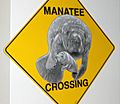West Indian manatee facts for kids
The West Indian manatee (Trichechus manatus), often called a "sea cow," is a type of manatee. It is the biggest living member of a group of animals called Sirenia. This group also includes dugongs and the Steller's sea cow, which is now extinct.
The West Indian manatee is a different species from the Amazonian manatee (T. inunguis) and the African manatee (T. senegalensis). There are two main types, or subspecies, of the West Indian manatee: the Florida manatee (T. m. latirostris) and the Antillean or Caribbean manatee (T. m. manatus). Some new research suggests there might even be three groups:
- Florida and the Greater Antilles
- Mexico, Central America and northern South America
- Northeastern South America.
Both the Florida manatee and the Antillean manatee are endangered. This means they are at risk of disappearing forever. Many groups, including government, private, and non-profit organizations, are working hard to protect these amazing animals. They face dangers from nature and from people, like getting hurt by boat propellers.
Contents
What are Manatees?
Manatees are large, slow-moving marine mammals. They are often called "sea cows" because they graze on plants in the water, much like cows on land. They have thick, wrinkled skin that is usually gray or brown. Manatees have two flippers at the front and a large, paddle-shaped tail. They use their flippers to steer and their tail to move through the water.
Where Manatees Live
West Indian manatees live in warm, shallow coastal waters. They can be found in rivers, estuaries, and oceans. They need warm water to survive, so in colder months, they often gather near natural springs or power plant outflows. These areas provide the warmth they need when the water temperature drops.
What Manatees Eat
Manatees are herbivores, meaning they only eat plants. They spend many hours each day grazing on seagrass, algae, and other water plants. An adult manatee can eat a lot of plants every day, sometimes up to 10% of its body weight! They use their flexible lips to grab plants and bring them to their mouths.
Protecting Manatees
Manatees are gentle creatures, but they face many threats. One of the biggest dangers comes from boats. Manatees often swim close to the surface, and they can be hit by boat propellers. This can cause serious injuries or even death. To help protect them, there are often "no wake" zones in areas where manatees live. These zones require boats to slow down.
Other Threats to Manatees
Besides boats, manatees can also be harmed by pollution in the water. They can get tangled in fishing gear, which makes it hard for them to swim or eat. Losing their habitat, like seagrass beds, also makes it harder for them to find food. Cold weather can also be a danger, as manatees need warm water to survive.
How People Help
Many people and groups are working to save manatees. They rescue injured or sick manatees and help them get better. They also teach people about manatees and how to protect them. Laws are in place to protect manatees and their homes. By working together, we can help ensure these wonderful "sea cows" continue to thrive in our waters.
Images for kids
-
Skull of a West Indian manatee on display at The Museum of Osteology, Oklahoma City, Oklahoma
-
Manatee from Crystal River, Florida
-
Basking at Haulover Canal, Merritt Island National Wildlife Refuge, Florida
-
West Indian manatee skeletons on display at the North Carolina Museum of Natural Sciences in Raleigh, North Carolina
See also
 In Spanish: Manatí del Caribe para niños
In Spanish: Manatí del Caribe para niños








